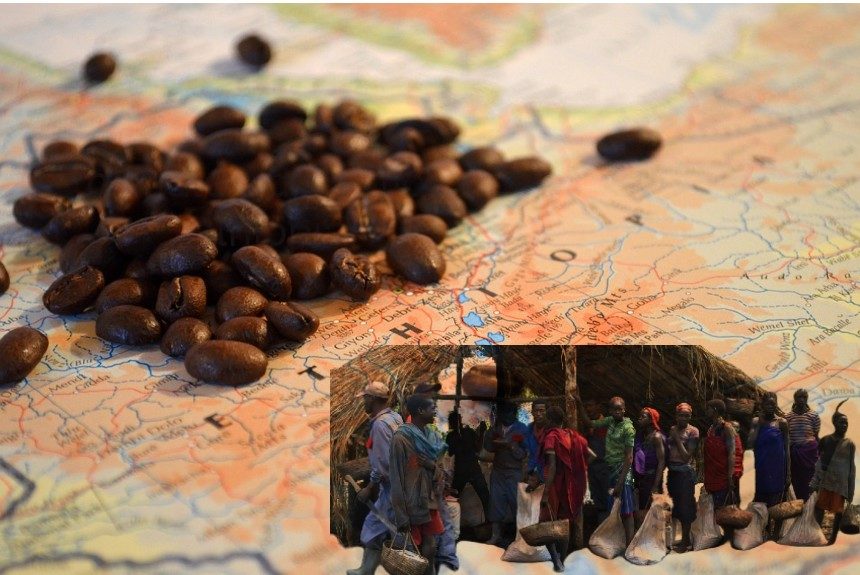The Ethiopian Marketplace reports that Ethiopia aims to be climate-neutral by 2025 and create more jobs by applying sustainable agriculture and restoring millions of hectares of its degraded forests.
According to the article, Ethiopia is Africa’s largest producer of coffee, and it is a source of livelihood for 15 million Ethiopians. According to a legend, a young goatherd, Khalid, discovered coffee in Kafa’s mountain forest when his goats ate the red berries and became rambunctious. He ate some as well, and that’s where it all started.
Coffee grows wild in Ethiopia, protected by mountain forest canopy in the regions close to the border with South Sudan.
When people think of Ethiopia, they tend to see it as an arid landscape due to the widespread images from the historic 1984 famine that devastated the country. However, the Bench-Sheko zone in the southwest part of the country is lush and green, with altitudes between 1500 and 2000 meters and receiving around 2 meters of rainfall each year.
Partnerships for Forests highlights the importance of Ethiopian forests for coffee growing and as a significant carbon sink. “Coffee grows in about 400,000 hectares of Ethiopia’s forests, including some of its last remaining old-growth forests, such as Kafa, Sheka, and Belete-Gera.
These forests are globally important because they sequester large amounts of carbon, promote biodiversity, and provide the genetic base for high-quality arabica coffee; the Kafa Forest alone contains over 5,000 coffee varieties.
However, Ethiopia’s natural forest has shrunk by a third due to agricultural expansion and demand for fuelwood used by communities. These forests can grow high-quality specialty coffee varieties that can offer premium prices for farmers, thus providing an incentive for them to preserve the forest.
Threats to coffee production and livelihoods
Deforestation and land degradation are essential threats to coffee production and the livelihoods of people depending on it. Because coffee shrubs grow under the shade and protection of mountain forests, deforestation and a short-term approach to land management put this precious produce at high risk.
Helping farmers to do sustainable farming practices
Phys.org reports that the University of Huddersfield, England, supports Ethiopia’s rural communities to do sustainable farming and help preserve its most precious product, coffee.
Professor Adrian Wood has been working and visiting Ethiopia since 1973, linking field research to teaching and advisory support for Ethiopia’s NGOs and government agencies. His work on the five-year Community Conservation of Wild Coffee and Natural Forest (CCWCNF) is funded by UK and US charities and additional support from the University.
The University partners with non-profit organisations to help create income opportunities for communities through protecting their forests. Locals are also taught about alternative and non-timber sources of income, such as growing and harvesting honey, fruit, and spices.
Participatory forest management
According to the Ecosystem Marketplace, Ethiopia is implementing a “participatory forest management” program to boost farm productivity as part of its Climate Resilient Green Economy (CRGE) strategy.
Under the participatory forest management program, farmers are responsible for caring for and managing their forests. They are trained in modern agroforestry and help establish self-governing cooperatives.
The country aims to regenerate 5 million hectares of forest by 2020, making its economy carbon-neutral by 2025 because growing forests absorb industrial GHGS. If everything goes to plan, Ethiopia’s economy will be climate-negative before 2030; its forests will absorb more GHG than it emits.
Agroforestry best practices and carbon offsets
According to the article, carbon finance plays a vital role in funding farmers’ efforts to regenerate their forests and implement agroforestry. Farmers in the district of Wolaita Sodo have experienced the benefits of agroforestry.
When farmers planted trees among their crops, it infused their soil with nitrogen, recharged 12 depleted springs, and provided employment for 2000 people.
Aside from the economic and environmental benefits farmers gained by practising agroforestry, carbon offsets generated by the trees financed the farmers’ efforts. Forest regeneration activities are funded through carbon finance and incentivise forest preservation through carbon offsets.
It funds projects that support sustainable farming practices, teach farmers alternative sources of income, preserve forests’ biodiversity, and help fight climate change.
To learn how carbon finance is helping coffee farmers in Ethiopia, click the link below.
Source Citation:
Zwick, S. (2018, January 16). How Ethiopia Is Slowing Climate Change By Reviving Its Forests – And Its Economy. Ecosystem Marketplace. Retrieved from https://www.ecosystemmarketplace.com/articles/how-ethiopia-is-slowing-climate-change-by-reviving-its-forests-and-its-economy/
Preserving coffee and forests in Ethiopia for a sustainable future. (2020, July 28). Phys.org. Retrieved from https://phys.org/news/2020-07-coffee-forests-ethiopia-sustainable-future.html
Premium wild coffee from Ethiopia’s standing forest. (2021). Partnership for Forests. Retrieved from https://partnershipsforforests.com/partnerships-projects/ethiopian-forest-coffee/



Leave a Reply